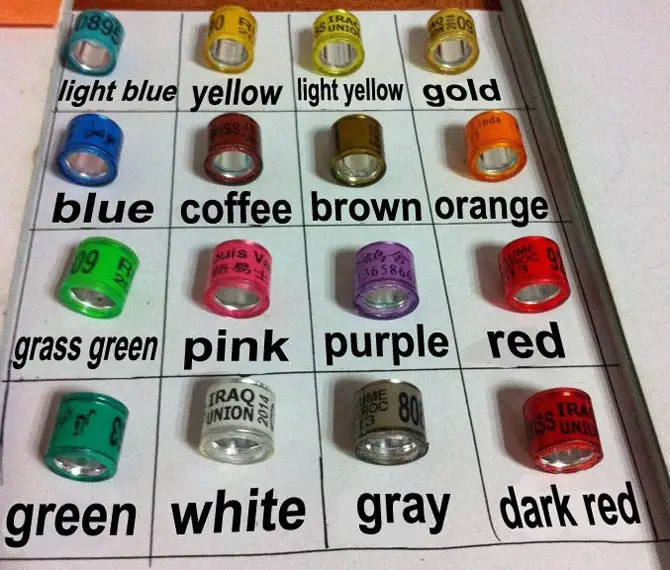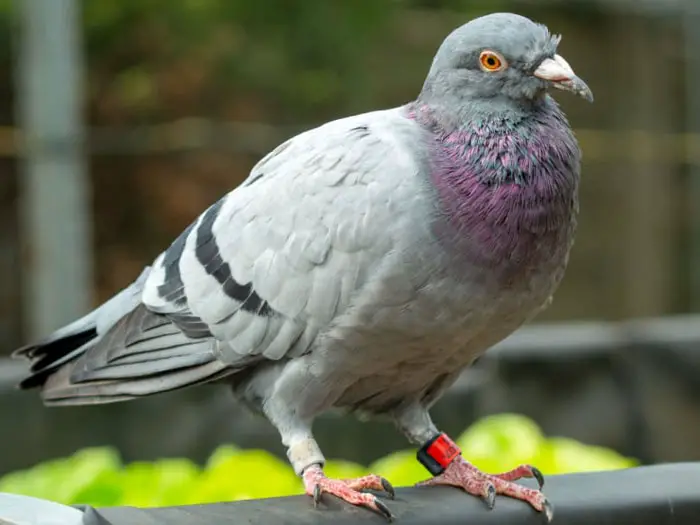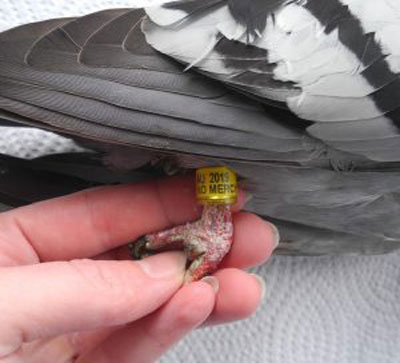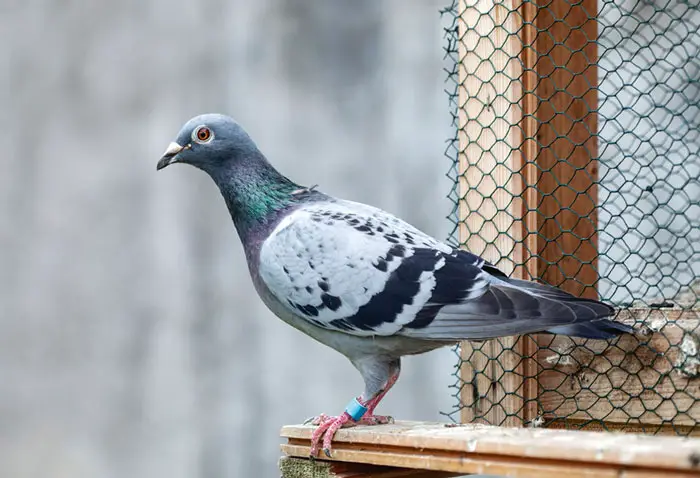Pigeon Band Colors Meaning (Surprising Insights Inside)
If you just found a pigeon with a colored band on its leg, you may be looking for answers on what the color means. Different people have spotted pigeons with different band colors from yellow to green, pink, red, blue, etc. This guide will discuss everything you need to know about these pigeon band colors and what they mean.
Pigeon band colors usually serve as vital markers that carry valuable information about a given pigeon, such as its age, origin, breeding program, and purpose. The color of the band is of less significance than the information contained in it.
This article will shed more light on the different band colors of pigeons and what they represent. We will also share other helpful info such as what different colors mean, how to read the information on the band, and what to do if you spot a pigeon with a colored band.
Pigeon Band Colors Meaning
Pigeon band colors are simply used for easy identification and tracking of the pigeon. The band attached to the bird’s legs gives helpful information about the pigeon such as its origin, background, purpose, breeding program, and so on.
These ID tags help solve disputes such as who owns a given bird and can help lost or injured pigeons find their way back home.
In most cases, the pigeons with bands on their legs are homing or racing pigeons.

So, if you find a pigeon with a colored band on its legs, it could mean they’re a homer or racing pigeon that’s just exhausted and taking some time to rest and feed before heading home again.
Sometimes, the bird may be injured or lost.
In some cases, the owner may not want the bird again since they want to maintain a competitive racing flock.
That said, the band colors do not matter much in identifying the pigeon than the numbers or info written on the band.
If you’re able to read these numbers, you can use them to try and track down the pigeon owners. And, hopefully, you can return the bird back to its rightful owner.
Note that the domesticated pigeons usually wear plastic bands and not metallic bands.
If you find a bird with a metallic band, it’s likely being used by scientists for study and research. Such bands are usually issued by the U.S. Fish and Wildlife Service for use in wild birds for research/study purposes.
However, the domesticated pigeon owners use plastic bands that might be registered by different unions such as the International Federation of American Pigeon Fanciers or American Racing Pigeon Union.
Overall, if you find any pigeon with a color band, it means it’s domesticated/tamed and not wild. If it’s catchable then you’d want to get it and take care of it as you try to reunite it with its owner.
You can read the number on the bird’s band and post it on pigeon forums or check other available resources to help you trace its home.
Pigeon with red band on leg meaning
If you come across a pigeon with a red band on its leg, it simply means it’s a homing or racing pigeon that got lost or injured. The red band means the bird has its owner.
You can look up the bird’s band for more information about its owner. To find its owner, you should be able to read the band.
If the band contains the owner’s contact info, then tracing the bird’s owner becomes even easier.

Pigeon with green band on leg meaning
A pigeon with a green band on its leg means that this is a domesticated bird that has lost its way, or it was injured along the way and could not finish its journey back home.
In this case, you’ll need to check the information on the band to help you trace the bird’s owner and hopefully reunite them.
Some owners usually provide their names and contact info on the bands, which can make it even easier to trace the bird’s home.

Pigeon with yellow band on leg meaning
A yellow brand also means the pigeon is domesticated (owned), so you may want to help reunite it with its owner.
It typically identifies racing pigeons that are involved in competitive events or races.
A pigeon with yellow should give you its history as well as the important role it played in breeding or racing.

Pigeon band number lookup
As we have said earlier, the information on the pigeon band usually provides crucial info that can help you trace a bird’s owner and help return it home.
In this section, we will teach you how to track the pigeon number.
Ideally, a band number should have a sequence of letters like this: IF-0000-XXXX-16.

Here’s what each letter and number means:
- Parent organization info: The first set of letters usually stands for the organization the pigeon is registered with. Some of the most common organizations for pigeons include the International Federation (IF), the American Union (AU), the National Pigeon Association (NPA), the Canadian Pigeon Union (CRPU or CU), and the Independent Pigeon Breeders group (IPB).
- Local club info: The next set of letter(s) represents the local club within any of the above organizations. The club info is usually indicated in the band’s third section. Note that each parent organization has an online database on all their local clubs.
- Serial number: Every pigeon in all local clubs gets a serial number (usually a 4-digit number (though it may be shorter or longer depending on the club). This number may be given to more than one bird in the group and helps identify the region. The serial number may appear immediately after the parent organization’s initials or club identification.
- Birth date: The two-digit set of numbers on the band’s 2nd or 4th position usually denotes the year the specific bird was hatched. This is usually easy to tell as it appears in only two digits.
Note that some pigeon owners may attach an additional band to their pigeons with their contact info to make it easier for the lost bird to be traced to their home.
Some pigeon owners who aren’t affiliated with any pigeon organization usually fit their birds with bands containing their names and contact info.
What to do if you find a banded pigeon?
If you find a banded pigeon, there are a few steps you can take to ensure the well-being of the bird and potentially reunite it with its owner.

This is what you should do:
Take care of the pigeon
The fact that the pigeon has a band means it’s domesticated and won’t be able to survive out there on its own. Therefore, you’ll need to provide it with temporary shelter.
If it looks exhausted or injured, we advise you to put it in a safe and comfortable enclosure. Make sure it has access to birdseed or grains and fresh water.
If the bird looks seriously injured or in distress, you may also consider consulting a local vet for guidance on how to take care of it.
Check the band
The first step is to examine the colored band on the bird. Take note of any letters, numbers, and band color. This is crucial info that will help you identify the bird’s owner and origin.
You may also find that some pet pigeons are simply banded with the owner’s name and phone number.

Some pigeon keepers might add their own band with this type of info on their bird’s legs in addition to the club bands. This helps make it easier for the lost birds to get back home easily.
Contact your local pigeon clubs
With the band information, you may try reaching out to your local pigeon clubs and organizations. They may help trace the owner of the pigeon using the band information. They may also offer additional tips on how to take care of the bird.
Make use of online resources
Some pigeon organizations also have databases on the web where you can enter the band details and find the owner of the pigeon.
You may also consider posting about the found pigeon on social media groups and online forums related to pigeons to see if you can reach the owner.
Consider keeping the bird or taking it to a rescue center
Sometimes looking for the bird’s owner isn’t the right option, especially for the sports bird. Remember, the info on the band is for recording winners not to recover the lost ones.
Therefore, if the bird is returned to its owner, it may end up being culled for being a failure and a threat to the bloodline and health of the other pigeons.

If you find a pigeon with the owner’s phone number and name, it’s probably just a pet pigeon and you may consider returning it to its owner.
However, if it’s kept for sport or business— e.g., a homer, racing, or fancy pigeons—it’s most likely deemed unworthy and unwanted by its owner. And you may want to keep it or take it to a rescue center. (Source).
Conclusion
A colored band on the pigeon’s leg, regardless of its specific color, usually means that the pigeon is domesticated or owned. The bird may be a homing racer that’s resting, injured, or got lost on its way back home. Or the owner may have released it for being a loser. The band contains information that can help identify the bird individually and even trace it back to its owner. The band information tells you about the bird’s origin, age, breeding program, its purpose, and even the reason for release.
If you find a banded pigeon, we advise you to check its band for more info about the bird. This way, you can trace it back to its owner and reunite them. Note that some owners usually put a band on their birds containing their contact info, which makes them even easier to trace. Using online resources for parent organizations the bird is affiliated to will help you easily reunite the bird with its owner.






